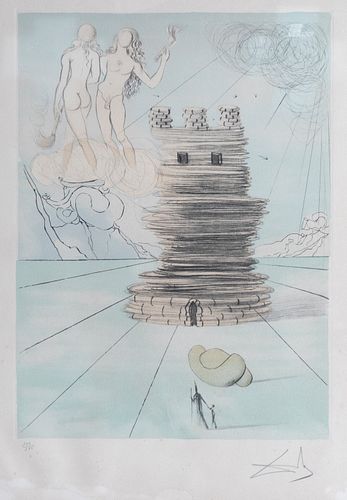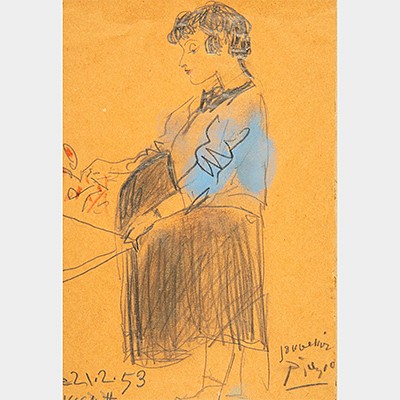SALVADOR DALÍ I DOMÈNECH (Figueras, Girona, 1904 - 1989). "Twelve tribes of Israel", 1973. Etching on Arches paper, copy 192/195. Signed and numbered
Lot 20
About Seller
Setdart Auction House
Carrer Aragó 346
Barcelona
Spain
Setdart Subastas was born in 2004 and is currently the first online art auction in Spain with solidity, prestige and reliability guaranteed by our more than 60,000 users. Setdart has a young, dynamic and enterprising team ready to successfully manage the purchase and sale of art works through custom...Read more
Categories
Estimate:
EUR€1,500 - EUR€1,800
$1,612.90 - $1,935.48
Absentee vs Live bid
Two ways to bid:
- Leave a max absentee bid and the platform will bid on your behalf up to your maximum bid during the live auction.
- Bid live during the auction and your bids will be submitted real-time to the auctioneer.
Bid Increments
| Price | Bid Increment |
|---|---|
| EUR€0 | EUR€10 |
| EUR€200 | EUR€25 |
| EUR€500 | EUR€50 |
| EUR€1,000 | EUR€100 |
| EUR€3,000 | EUR€200 |
| EUR€5,000 | EUR€500 |
| EUR€10,000 | EUR€1,000 |
| EUR€20,000 | EUR€2,000 |
| EUR€50,000 | EUR€5,000 |
About Auction
By Setdart Auction House
Sep 20, 2021
Set Reminder
2021-09-20 08:00:00
2021-09-20 08:00:00
America/New_York
Bidsquare
Bidsquare : CONTEMPORARY ART
https://www.bidsquare.com/auctions/setdart-auction-house/contemporary-art-7482
Setdart Auction House sofia@setdart.com
Setdart Auction House sofia@setdart.com
- Lot Description
SALVADOR DALÍ I DOMÈNECH (Figueras, Girona, 1904 - 1989). "Twelve tribes of Israel", 1973. Etching on Arches paper, copy 192/195. Signed and numbered in pencil. Reference: The official catalogue of the graphic works of Salvador Dalí, pg.78, figure 72-6. Measurements: 48.3 x 35.6 cm (print); 63.5 x 50.8 cm. (paper); 87 x 73 cm (frame). Salvador Dalí was one of the leading exponents of the surrealist movement. His work greatly influenced the direction of Surrealism during the 1920s and 1930s, and he is acclaimed as the creator of the paranoiac-critical method, an essential combination of the real and the imaginary. During his early years, Dalí discovered contemporary painting during a family visit to Cadaqués, where he met the family of Ramon Pichot, an artist who travelled regularly to Paris. Following Pichot's advice, Dalí began to study painting with Juan Núñez. In 1922, Dalí stayed at the famous Residencia de Estudiantes in Madrid to begin studying Fine Arts at the San Fernando Academy. However, before his final exams in 1926, he was expelled for claiming that there was no one there fit to examine him. That same year Dalí travelled to Paris for the first time. There he met Picasso, and established certain formal characteristics that would become distinctive of all his work from then on. During this period Dalí held regular exhibitions in both Barcelona and Paris, and joined the Surrealist group based in the Parisian district of Montparnasse. The painter landed in America in 1934, thanks to the art dealer Julian Levy. Following his first solo exhibition in New York his international reputation was definitively consolidated, and from then on he exhibited his work and gave lectures all over the world. Most of his production is housed in the Dalí Theatre-Museum in Figueras, followed by the collection of the Salvador Dalí Museum in St. Petersburg (Florida), the Reina Sofía in Madrid, the Salvador Dalí Gallery in Pacific Palisades (California), the Espace Dalí in Montmartre (Paris) and the Dalí Universe in London.
- Shipping Info
-
In-house shipping available. Please inquire at admin@setdart.com.
-
- Buyer's Premium



 EUR
EUR CAD
CAD AUD
AUD GBP
GBP MXN
MXN HKD
HKD CNY
CNY MYR
MYR SEK
SEK SGD
SGD CHF
CHF THB
THB















